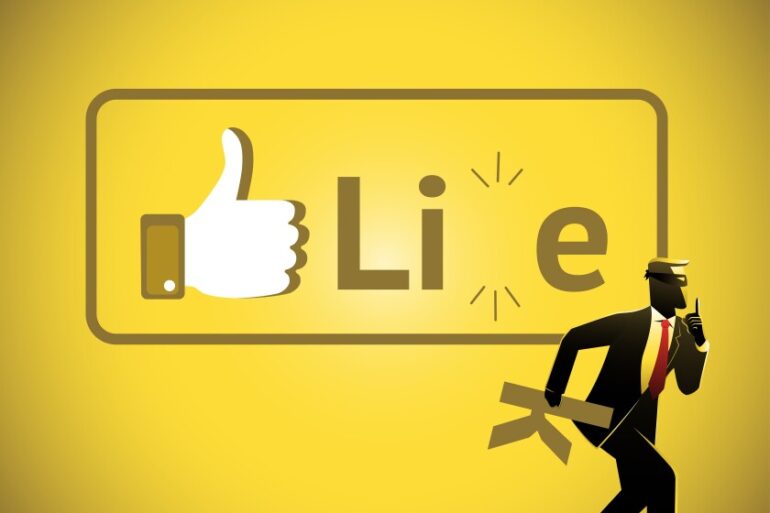Ever read something online and thought, “That sounds like total garbage”?
Every clickbait headline, miracle cure, or social media thread promising secret wealth hacks has one goal—trick you.
The internet isn’t a magical land of truth. It’s a crowded market. And in that market, some sellers are honest. Others are selling snake oil dressed up in SEO.
Let’s sniff it out.
🔑 Key Highlights
- Online lies are sneakier than ever.
- Fake authority can look real.
- Everyone is a “coach” now.
- Your brain wants to believe lies.
- Free tools exist to detect AI content.
- Not all red flags come in red.
- Being alert beats being reactive.
Online lies now wear better suits

The internet used to be a wild west. Now it’s a polished casino. The smoke cleared, but the tricks got slicker.
Influencers with zero training talk about health like they’ve spent decades in labs. Financial “gurus” pitch advice that would bankrupt your grandma. Travel bloggers review resorts they’ve never even seen in person. The deception isn’t always loud. Sometimes it whispers.
Want to sniff out machine-written nonsense? Use a reliable AI detector. Try ZeroGPT. Their DeepAnalyse Technology doesn’t just run a shallow scan. It works in layers, zooms in on patterns, and checks against real human language. It even compares content to known outputs from models like GPT and Gemini.
Don’t guess. Test.
Your brain is wired to trust what feels familiar
Here’s the ugly truth. Your brain isn’t built for the internet. It’s built for survival. It likes patterns. It craves shortcuts. It trusts repetition.
So when you see the same advice everywhere, your brain relaxes. “Everyone’s saying it, so it must be true.”
That’s how lies spread fast.
The fix? Interrupt the autopilot.
- Pause when something sounds too good
- Ask: “Who benefits if I believe this?”
- Reverse-search claims or quotes
Truth doesn’t beg for attention. Lies scream.
Not every influencer knows what they’re talking about
Anyone can sound smart for 60 seconds. Especially with jump cuts, background music, and dramatic hand gestures. But being loud isn’t the same as being right.
Fake experts thrive on platforms where image beats substance.
Here’s how they trap people:
- Using vague terms that sound technical but mean nothing
- Quoting studies without links or names
- Throwing around phrases like “research shows” or “scientists agree”
Tip: If you can’t trace the source, it doesn’t count.
Spot the red flags faster with a few brutal filters

Online trust shouldn’t be automatic. You need filters. Cold, unflinching filters.
Here’s one brutal checklist:
- Are they selling something immediately after the advice?
- Do they promise “one secret,” “one trick,” or “a hack” for massive results?
- Do they claim “they don’t want you to know” something?
- Do they scare you, then pitch safety?
- Do they cite zero proof, or link to shady pages?
If it feels manipulative, it probably is.
Viral doesn’t mean valuable
Here’s a bitter pill: The most shared advice is often the worst. Why? Because simplicity spreads faster than accuracy. Drama spreads faster than nuance.
Think about it.
A tweet with “Cure your anxiety in 3 steps!” will go viral. A deep dive into mental health science won’t.
So don’t confuse popularity with truth.
- Ask: “Does this person have credentials?”
- Search their name plus ‘scam’ or ‘fraud’
- Avoid putting blind faith in followers count
Clout doesn’t equal credibility.
Lies love urgency—slow down before clicking or reacting
Deception thrives when you’re in a rush. The goal is panic. Confuse you. Trigger emotions. Then hit you with a link or an offer.
Want to know their tactics?
- Countdown timers on fake product launches
- Fake scarcity—“Only 2 left in stock!”
- Phrases like “Act now or regret forever”
- Emotional stories with no verifiable names or sources
Slow is smooth. Smooth is safe. If someone’s rushing you, don’t trust them.
You are the product—and the bait
Ads disguised as articles. Sponsored posts without labels. Influencers who “just love this thing so much” but got paid five grand to say it. Welcome to the marketing jungle.
You think you’re reading advice. You’re actually reading a pitch.
Ask yourself:
- Is there an affiliate link tucked in the text?
- Does every tip point toward a product?
- Are they pretending to be neutral but end with a glowing review?
You’re not a fool. But they’re betting you won’t notice.
Even fake facts sound smart with enough confidence
Let’s play a quick game. Which sounds more believable?
“New research shows sugar heals liver damage.”
or
“There’s no consensus, and more studies are needed.”
The first one wins every time. Even though it’s total fiction.
Confident delivery makes nonsense feel true. That’s the trap.
Here’s your defense:
- Search exact phrases. See if any legit journal pops up.
- If a study is mentioned, it better have a source.
- Watch for words like “may,” “could,” or “believed to”—they hide uncertainty
Science isn’t a slogan.
Your emotions are the easiest entry point for online manipulation

Fear. Anger. Envy. Nostalgia. These aren’t just feelings. They’re buttons. And someone’s always pushing them.
Why?
Because emotional people click faster and buy faster.
Let’s unpack the emotional bait:
- Headlines that make you angry
- Stories designed to make you cry or cheer
- Content that “feels personal” but speaks to millions
- Testimonials that sound too perfect
If you feel hooked before you even think, that’s a trap.
Just because you saw it “everywhere” doesn’t mean it’s real
Repetition isn’t proof. Lies repeat better than facts. They’re short. Catchy. Often rhyme. And once your brain stores it, it feels true. Even if it’s trash.
So if you see the same claim on five websites, ask:
- Do they all link back to the same source?
- Is that source credible or another opinion blog?
- Can you trace the claim beyond influencer circles?
Echo chambers are loud, not wise.
Spotting deception gets easier once you expect it by default
Here’s a mindset shift. Expect dishonesty. Not because the world’s evil. But because attention is money. Truth doesn’t always pay. But clicks do.
So flip the script.
Don’t hope it’s true. Assume it isn’t. Then go prove it wrong.
It saves time. It protects your wallet. It shields your peace of mind.
Plus, it forces fake experts to earn your trust.
Final dose of honesty: most online lies survive because people don’t check

The problem isn’t just liars. People see something, share it, forget it. That’s how false info becomes folklore.
You don’t need to start arguments or roast strangers. But don’t stay silent.
Say: “Where’s the source?”
Ask: “Who wrote this?”
Search: “Is that even real?”
You don’t need to be a hater. Just don’t be a fan of fiction.
- Popularity means nothing without proof.
- Credentials beat charisma.
- AI detection is your ally.
Next time you scroll, ask more. Trust less. Be the person that refuses to be spoon-fed garbage.
If someone tries to sell you “the truth,” ask for a receipt.
